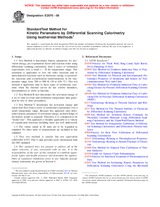We need your consent to use the individual data so that you can see information about your interests, among other things. Click "OK" to give your consent.
ASTM E2070-08
Standard Test Method for Kinetic Parameters by Differential Scanning Calorimetry Using Isothermal Methods
STANDARD published on 1.2.2008
The information about the standard:
Designation standards: ASTM E2070-08
Note: WITHDRAWN
Publication date standards: 1.2.2008
SKU: NS-44186
The number of pages: 11
Approximate weight : 33 g (0.07 lbs)
Country: American technical standard
Category: Technical standards ASTM
Annotation of standard text ASTM E2070-08 :
Keywords:
activation energy, autocatalytic reactions, crystallization reactions, differential scanning calorimetry (DSC), frequency factor, kinetics, nth order reactions, pre-exponential factor, reactions, thermal analysis, thermoset cure, Activation reactions, Autocatalytic reactions, Crystallization transformation, Differential scanning calorimetry (DSC), Exothermic temperature analysis, Frequency factor, Isothermal conditions/testing, Kinetic behavior/characteristics/parameters, nth order reactions
Additional information
| Significance and Use | ||||||||||||||||||||||||||||||||||||
|
This test method is useful for research and development, quality assurance, regulatory compliance and specification acceptance purposes. The determination of the order of a chemical reaction or transformation at specific temperatures or time conditions is beyond the scope of this test method. The activation energy results obtained by this method may be compared with those obtained from Test Method E 698 for nth order and autocatalytic reactions. Activation energy, pre-exponential factor and reaction order results by this method may be compared to those for Test Method E 2041 for nth order reactions. |
||||||||||||||||||||||||||||||||||||
| 1. Scope | ||||||||||||||||||||||||||||||||||||
|
1.1 Test Method A determines kinetic parameters for activation energy, pre-exponential factor and reaction order using differential scanning calorimetry from a series of isothermal experiments over a small (∼ 10 K) temperature range. This treatment is applicable to low nth order reactions and to autocatalyzed reactions such as thermoset curing or pyrotechnic reactions and crystallization transformations in the temperature range from 300 to 900 K (30 to 630 °C). This test method is applicable only to these types of exothermic reactions when the thermal curves do not exhibit shoulders, discontinuities or shifts in baseline. 1.2 Test Method B also determines the activation energy of a set of time-to-event and isothermal temperature data generated by this or other procedures. 1.3 Test Method C determines the activation energy and initial heat flow from a series of isothermal experiments over a small temperature range. Because this approach only determines kinetic parameter of activation energy, no knowledge of the kinetic model is required. Therefore it is considered to be “model free”. This approach is broadly applicable to a variety of complicated reactions including those not well understood. 1.4 SI units are the standard. 1.5 This test method is similar but not equivalent to ISO 11357, Part 5, and provides more information than the ISO standard. 1.6 This standard does not purport to address all of the safety concerns, if any, associated with its use. It is the responsibility of the user of this standard to establish appropriate safety and health practices and determine the applicability of regulatory limitations prior to use. Specific precautionary statements are given in Section 8. |
||||||||||||||||||||||||||||||||||||
| 2. Referenced Documents | ||||||||||||||||||||||||||||||||||||
|
We recommend:
Technical standards updating
Do you want to make sure you use only the valid technical standards?
We can offer you a solution which will provide you a monthly overview concerning the updating of standards which you use.
Would you like to know more? Look at this page.




 Cookies
Cookies
